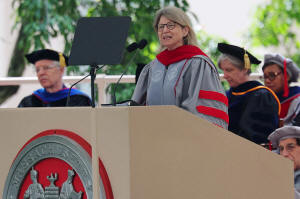|
The proportion of Asian American students in the incoming class
rose from 41% to 47%, while white students made up about the
same share of the class as in recent years.
MIT administrators said the statistics are the result of the
Supreme Court's decision last year to ban affirmative action, a
practice that many selective U.S. colleges and universities used
for decades to boost enrollment of underrepresented minority
groups.
Harvard and the University of North Carolina, the defendants in
the Supreme Court case, argued that they wanted to promote
diversity to offer educational opportunities broadly and bring a
range of perspectives to their campuses. The
conservative-leaning Court ruled that their race-conscious
admissions practices violated the U.S. Constitution's promise of
equal protection under the law.
"The class is, as always, outstanding across multiple
dimensions," MIT President Sally Kornbluth said in a statement
about the Class of 2028.
"But what it does not bring, as a consequence of last year’s
Supreme Court decision, is the same degree of broad racial and
ethnic diversity that the MIT community has worked together to
achieve over the past several decades."
This year's freshman class at MIT is 5% Black, 1% American
Indian/Alaskan Native, 11% Hispanic and 0% Native
Hawaiian/Pacific Islander. It is 47% Asian American and 37%
white. (Some students identified as more than one racial group).
By comparison, the past four years of incoming freshmen were a
combined 13% Black, 2% American Indian/Alaskan Native, 15%
Hispanic and 1% Native Hawaiian/Pacific Islander. The previous
four classes were 41% Asian American and 38% white.
U.S. college administrators revamped their recruitment and
admissions strategies to comply with the court ruling and try to
keep historically marginalized groups in their applicant and
admit pool.
Kornbluth said MIT's efforts had apparently not been effective
enough, and going forward the school would better advertise its
generous financial aid and invest in expanding access to science
and math education for young students across the country to
mitigate their enrollment gaps.
(Reporting by Gabriella Borter; editing by Paul Thomasch and
Aurora Ellis)
[© 2024 Thomson Reuters. All
rights reserved.]
Copyright 2022 Reuters. All rights reserved. This material may
not be published, broadcast, rewritten or redistributed.
Thompson Reuters is solely responsible for this content.

|
|




